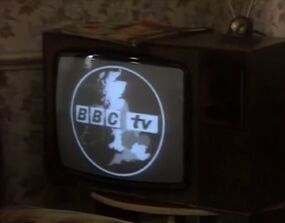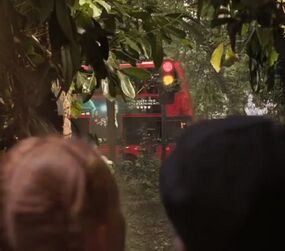User:Epsilon/Sandbox Four: Difference between revisions
No edit summary Tag: 2017 source edit |
No edit summary Tag: 2017 source edit |
||
| Line 27: | Line 27: | ||
A BBC science fiction series beginning ''Doc-'' was first broadcast on [[BBC television|television]] at 5:15 [[PM|pm]] on [[Saturday]] [[30 November|30th of November]], 1963. ([[TV]]: ''[[Remembrance of the Daleks (TV story)|Remembrance of the Daleks]]'', [[PROSE]]: ''[[Who Killed Kennedy (novel)|Who Killed Kennedy]]'') | A BBC science fiction series beginning ''Doc-'' was first broadcast on [[BBC television|television]] at 5:15 [[PM|pm]] on [[Saturday]] [[30 November|30th of November]], 1963. ([[TV]]: ''[[Remembrance of the Daleks (TV story)|Remembrance of the Daleks]]'', [[PROSE]]: ''[[Who Killed Kennedy (novel)|Who Killed Kennedy]]'') | ||
One serial would receive a [[Target Books (Bafflement and Devotion)|novelisation]], called ''[[Doctor Who in an Exciting Adventure with the Daleks]]'', which contradicted another | One serial would receive a [[Target Books (Bafflement and Devotion)|novelisation]], called ''[[Doctor Who in an Exciting Adventure with the Daleks]]'', which contradicted another [[An Unearthly Child (book)|book]]. ([[PROSE]]: ''[[Bafflement and Devotion (short story)|Bafflement and Devotion]]'') | ||
Early on in the series, there were [[Tribe of Gum|Cavemen]], [[Dalek]]s, [[Aztec]]s and [[Marco Polo]]. ([[PROSE]]: ''[[Verity (short story)|Verity]]'') | Early on in the series, there were [[Tribe of Gum|Cavemen]], [[Dalek]]s, [[Aztec]]s and [[Marco Polo]]. ([[PROSE]]: ''[[Verity (short story)|Verity]]'') | ||
Revision as of 01:17, 5 December 2020
- You may wish to consult
Doctor Who (disambiguation)for other, similarly-named pages.
Doctor Who was a BBC science fiction/drama series that premiered in late 1963.
The series oriented around the adventures of the eponymous time traveller, commonly referred to as "the Doctor".
History
Development
After becoming too well recognised in Earth history, the Doctor presumably had retconned themselves into popular culture; (PROSE: Afterword) subsequently, on the 26th of March, 1963, Winston Churchill sent a letter a Mr Newman, to pitch the concept of a show about Churchill's old friend, the Doctor. (PROSE: Stop, Thief!)
A young woman, Verity, went to the BBC, and became the producer of the show, despite the protests of the "Men Who Knew What To Do". By standing her ground against their blatant sexism, she helped the Doctor Who series flourish with her creative ideas. (PROSE: Verity)
In the 20th century
A BBC science fiction series beginning Doc- was first broadcast on television at 5:15 pm on Saturday 30th of November, 1963. (TV: Remembrance of the Daleks, PROSE: Who Killed Kennedy)
One serial would receive a novelisation, called Doctor Who in an Exciting Adventure with the Daleks, which contradicted another book. (PROSE: Bafflement and Devotion)
Early on in the series, there were Cavemen, Daleks, Aztecs and Marco Polo. (PROSE: Verity)
Sometime in the 1970s, Terrance Dicks listened in to a conversation a Doctor Who fan from the future, who was asking UNIT for help regarding COVID-19. He would join in on the conversation a few minutes later, where he came up with a name for a Doctor Who story, "who's for a brew". He wrote it down, intending to share it with Barry, before disconnecting from the call. (WC: U.N.I.T. On Call)
In 1971, the serial The Claws of Axos aired. There was, at least according to Claudia Winkleman in 2013, an "alien duplication unit", present in the story. (TV: The Doctor Appears)
In 1974, an episode of the series aired, portraying the regeneration of Third Doctor into his next incarnation, the Fourth Doctor. (PROSE: Fanboys)
In 1978, Iris Wildthyme was sent by the Ministry to investigate Geoff Love as the Ministry suspected him of secreting in subliminal messages into his reworkings of TV sci-fi themes. Iris helped Geoff develop the Doctor Who theme while proving that the Ministry was indeed correct with their suspicions. (PROSE: Bafflement and Devotion)
Prior to 1981, serials known as The Seeds of Doom, State of Decay, Planet of the Spiders, and and unnamed serial aired, the latter of which depicted the Fourth Doctor's regeneration into the Fifth Doctor, who was set to return in the following season. By this time, the Wirrn, Zarbi, Sontarans, Krynoids, Zygons, Mechanoids, Yeti, and the Brain of Morbius all had been featured in the show, serving the role of the villains.
By early 1981, David and Chris were major fans of the series. They obsessed over the series, and when they went to Darlington on a semi-regular basis, they would be treated by their parents, who took them into WHSmith's to buy Target novelisations of Doctor Who stories. On one such occasion, they bought copies of State of Decay and Planet of the Spiders. (PROSE: Fanboys)
In the late 1990s, an unspecified incarnation of the character was portrayed by Paul McGann in the Doctor Who TV movie. (PROSE: Hospitality)
In the 21st century
Around the early 2000s, Paul Magrs wrote in a short piece of prose about his books and inspritations. In this piece, he stated that the second and fourth incarnations of the Doctor resembled Patrick Troughton and Tom Baker, respectively, and that his collection of all 150 Target novels written by Terrance Dicks had been stolen. (PROSE: Bafflement and Devotion)
By the 21st century, Cybermen, Weeping Angels, Sontarans and Slitheen had appeared. David Karpagnon, an orphan with dissociative personality disorder, watched the show around this time. The Doctor helped him with his problems from inside his head. (PROSE: The Terror of the Umpty Ums) In the early 2010s, Matt Smith was an actor in the series. (TV: The Doctor Drops In, The Doctor Appears)
On 21 June, 2012, a live news broadcast was filmed outside the Doctor Who Experience, when the exhibits (a Cybermen, a Scarecrow, an Ood, a Silent and the Eternal Dalek) turned out to be the real deal, and they burst through the wall of the experience, terrorising the public. (WC: Monster Escape)
On Red Nose Day 2013, Dermot O'Leary surprised his co-presenter Claudia Winkleman with a guest appearance of the Eleventh Doctor. At the event, an episode of Doctor Who plays on screen behind them, and Claudia chases the Doctor around. (TV: The Doctor Appears) Later that year, The Day of the Doctor was broadcast in 3D. (TV: The Doctor Appears, WC: The Zygon Isolation)
In November 2014, (PROSE: "Assessing the Risk") when the Earth became overgrown with trees, a double decker bus had an advertisement on its side, depicting the TARDIS and individuals closely resembling the Twelfth Doctor and Clara Oswald. An unknown source rated the show four stars out of five commenting "A-MAZE-ING ENTERTAINMENT!". (TV: In the Forest of the Night)
Around October of 2015, the ninth series of the show was broadcast on BBC One, starring another unspecified incarnation, who travelled with a companion called Clara; the twelfth incarnation of the Doctor bore a great similarity to this fictional depiction, and the same could be said about Clara Oswald. (WC: The Zygon Isolation)
By sometime prior to Christmas 2016, (TV: 2016 BBC Christmas ident) the ninth series aired, which consisted of the episodes The Magician's Apprentice, The Witch's Familiar, Under the Lake, Before the Flood, The Girl Who Died, The Woman Who Lived, The Zygon Invasion, The Zygon Inversion, Sleep No More, Face the Raven, and Heaven Sent. (WC: The Zygon Isolation)
By May 2020, the show had 12 series and 167 episodes that were available on BBC iPlayer. There also a periodical called Doctor Who Magazine. (WC: The Zygon Isolation) Also by this time, the Doctor was portrayed by a female actress. (PROSE: The Terror of the Umpty Ums, WC: The Zygon Isolation)
On 10 May, 2020, the two Osgoods conversed over Zoom. Afterwards, one of the duo went onto BBC iPlayer after ending the chat, scrolling past several episodes of Doctor Who from series nine, until she decided to watch The Zygon Invasion. (WC: The Zygon Isolation)
In late 2020, after a fan finished watching an episode, she rang UNIT in the 1970s, asking for help from the real Third Doctor, Jo, and the Brigadier, and they told her to remain positive despite the hardships. They disconnected, and Terrance Dicks then applauded the trio, and told the fan a tea break was deserved. He then came up with an idea for the name of a story, and then too disconnected. The fan then drank a cup of tea while watching an older episode of Doctor Who. (WC: U.N.I.T. On Call)
Other accounts
Info about The Time Surgeon, Doctor X, Professor X, Doctor Omega, and Comic Relief spectacular needs to be added.
Other accounts of the Doctor appearing in Earth fiction, sometimes as a character called "Doctor Who", suggested that some of the movies and TV programmes about the character were based on records and testimonies of the real Doctor. (PROSE: Stop, Thief!, Salvation, The Day of the Doctor) It has been suggested that when the Doctor's existence has become too noticeable to a world, they have a favorite "panic button", going back in time and introducing themselves as a fictional character in that world's mythology. (PROSE: Afterword)
Parallel timelines
In one reality, where the Doctor did not appear to ever have existed as a real individual, from 19 September to 24 October 1964, a six-part story entitled The Outlaws was first broadcast, starring actor William Hartnell as a version of the First Doctor. The six episodes were titled: "The Deserted Castle", "The Thief of Sherwood", "The Alchemist", "Errand of Mercy", "Ransom" and "A Guest For the Gallows". Episodes 3 and 5 were missing but still existed as off-air recordings. It had the production code "I".
The guest cast for "The Deserted Castle" included William Russell in a dual role also as Robin Hood, Archie Duncan as Little John, Ronald Hines as Will Scarlet, Frank Thornton as the Sheriff of Nottingham, Anneke Wills as Maid Marion, Milton Johns as the peddler, Carl Bernard as a villager and Ivor Colin as a man-at-arms. The writer was Godfrey Porter, the title music was by Ron Grainer with the BBC Radiophonic Workshop, the incidental music was composed and conducted by Harper C Bassett, the story editor was David Whitaker, the designer was Barry Newbery, the associate producer was Mervyn Pinfield, the producer was Verity Lambert and the director was Patrick Whitfield.
While doing an alchemy demonstration for the Sheriff in Episode 3, the Doctor nearly blows himself up while mixing chemicals, leaving him absent for two episodes while Hartnell recovered from a short illness.
The Daleks appeared in one of the first eight stories of this version of Doctor Who; the tenth story was titled Planet of Giants and followed on from a cliffhanger in which the fault locator warned of a build-up of pressure within the TARDIS.
In 1986, Godfrey Porter wrote a novelisation of The Outlaws entitled The Thief of Sherwood for Target Books. (PROSE: The Thief of Sherwood)
The Eighth Doctor encountered a version of the Doctor Who TV series in a parallel universe where he realised that he did not exist as a real individual; instead, he encountered the actor Tom Baker, who resembled the Doctor's fourth self. (COMIC: TV Action!)
The Eleventh Doctor also found himself stranded in a "meta-fictional" Parallel universe where Doctor Who existed as a TV programme with a long and storied history; to his surprise, all of the series' episodes matched events in his past exactly. (COMIC: The Girl Who Loved Doctor Who)
Another universe existed where Doctor Who was the failed creation of Martin Bannister; in the original timeline, it was extremely popular, but excessive time travel caused the programme to be effectively replaced by Juliet Bravo. (AUDIO: Deadline, PROSE: All Our Christmases)
Behind the scenes
History of the concept
The existence of the TV series Doctor Who within the Doctor Who universe is a metafictional gimmick with a long and storied history within licensed Doctor Who fiction. The show itself stopped just shy of confirming the existence of a series called Doctor Who within its universe on two occasion; the first was in Remembrance of the Daleks, where a TV series whose title began with "Doc…", and which debuted on the same date as the real-life Doctor Who, was briefly mentioned — only for the characters (and viewers) to miss the full name of the programme. Many years later, a poster featuring the Twelfth Doctor, Clara Oswald and the Doctor's TARDIS was glimpsed in the background of the Series 8 episode In the Forest of the Night, but with no title visible.
As a significant part of popular culture of Earth history in their own universe, television programmes and books based upon the Doctor have also been referenced in other in-universe sources; some, like Sarah Jane Smith's Doctor series, were reminiscent but distinct from real-life Doctor Who productions, while others, such as the mention of the two Peter Cushing movies in Steven Moffat's Day of the Doctor novelisation, intentionally matched pieces of real-life Doctor Who fiction. However, though instances such as the short story Stop, Thief! (where Winston Churchill commissions a "BBC TV programme about the Doctor's life") push the implication as far as it may be pushed, no story deemed valid by this Wiki has yet directly posited an in-universe TV series called Doctor Who as existing in the Doctor's own universe and being based in some obvious causal manner on the Doctor's "real" exploits. The 2020 webcast The Zygon Isolation came closest, but still did not explicitly spell out that its account of an in-universe Doctor Who was causally based on the real Doctor's adventures.
As an in-universe concept, Doctor Who has been more consistently used in parallel universes — where the logically thorny implications of the series known to the viewer simultaneously being a true account of a time-traveller's life, and a piece of fiction which the same individual could theoretically watch, would be lessened. The Eighth Doctor discovered the existence of Doctor Who in TV Action! while the Eleventh Doctor dealt with chapters of his life being chronicled as episodes of a television programme in The Girl Who Loved Doctor Who. The articles from The Thief of Sherwood, which depict an adventure with the First Doctor, Susan, Ian and Barbara where they meet Robin Hood, is placed in "an alternate version of our world", belonging to the Doctor's multiverse, by authorial intent.



